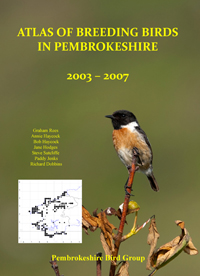Desert Wheatear - 1997 - first for Pembrokeshire
 Monday, January 13, 2014 at 12:33PM
Monday, January 13, 2014 at 12:33PM Oenanthe deserti
At 14:15 on Friday 12 December 1997, whilst taking a final stroll around the island before our departure for the winter months (planned for the following day), Theresa Purcell and I were surprsed to come across a bird! Any bird! For in recent days gale-force winds had blown incessantly, and there were very few signs of life all! However, on the ground about 20m ahead of us, a pale head appeared from behind a thrift tussock, and my immediate impression was "wheatear". Then shock set in, for this was the month of December, and it couldn't opposibly be a Northern Wehatear, surely not! It then emerged into the open, and its pale plumage became apparent. After having seen an Isabelline Wheatear Oenanthe isabellina at this very spot in September, there was a brief feeling of deja vu. It became apparent, however, that this was diminutive by comparison. Both Theresa and I excitedly uttered our feelings simultaneously - "Desert Wheatear"!
And the timing was right. The bird seemed tired, certainly not wary of us, and we continued our approach as it wandered amongth the clumps of vegetation. Over the next ten minutes we observed the bird from down to 15 metres, during which time it flew a short distance only a rock outcrop and preened, before flying some 100 metres and out of sight on the coastal slope. It was indeed a desert whatear, the first recorded on Skokholm, and in Pembrokeshire, and we were elated. But also frustrated that as far as other birders were concerned, the timing was very wrong and nobody else was going to see it. However, the image of the bird was preserved for posterity on the toilet wall, in the form of a splendid painting by Theresa.
Description:
General appearance: A a pale, eye-catching wheatear. Features of note included its small size, upright stance and dumpy appearance, more reminiscent of chats; wing feathers broadly edged buff-white, buff-coloured rump; whole tail brown-black; and along with the primaries and alula, the darkest part of the plumage. There was a slight contrast between upper- and under-parts.
Size and structure: Despite having no other bird alonside for a direct size comparison, the wheatear was immediately noticeably smaller than northern wheatear Oenanthe oenanthe of the nominate race. It also had entirely different proportions,: a dumpy body, with neck-less appearance (possibly caused by its tiredness), despite it always standing very upright. The primary extension was shorter than tertial length, mostly obscuring the rump and extending across part of the upper-tail. The bill was quite slender.
Plumage: Crown, nape, sides of neck, mantle and scapulars all pale milky-coffee brown; wings with lesser and greater coverts with broad pale buff-white edges virtually obscuring dark (brownish-black) centres, but less so on median covnerts. Tertials and secondaries also dark with pale edges. Primaries almost black, with pale tips. The alula, being black, was the darkest part of the wing, and stood out noticeably.
The face had no feature to cause it to stand out, at times appearing a uniform pale sandy-buff. An indistinct, pale buffish-white supercilium ran form the forehead to over the eye (head-on views showed supercilia to meet above the bill), then to above the rear ear coverts. It was not visible all of the time, depending upon the position of the bird and thus the angle of incidence of the light, similarly with the loral bar and ear coverts, which were diffuse pale buff. At one moment the breeze caused the feathers on one side of the throat to move, briefly revealing a diffuse blackish patch at their base. But otherwise the throat was off-white, a distinct contrast to the upper breast which was buff-peach, forming a breast band, the belly was also off-white.
The folded tail appeared all brownish-black above and below. This was confiremd as the bird flew, conspicuously lacking the inverted "T" and white sides to the upper-tail of other wheatears. Also, a particularly noticeable feature was the buff-coloured rump, obvious in flight, but obscured by the closed wings when the bird was on the ground. The underwing coverts and axillaries were pale, and the upper-wings were almost as pallid, no doubt due to the broad pale fringes to all feathers.
Bare parts: Iris, bill and legs all black. There was a pale, whitish eye-ring.
Behaviour: The bird was particularly approachable, but appeared tired, thus allowing close views, although it did stand partiuclarly upright at times and frequently wagged its tail up and down. When it flew off it appeared very chat-like, direct, with whirring wings. It flew for c.100metres, whence it dipped out of sight. Unfortunately we did not see it again, and left the island the following day.
Identification: The pale brownish-coloured upperparts, combined with pale underwing, led us to conclude that the bird was of the East Asian race O d atrogularis. It was probably afemale.
Graham Thompson
Pembrokeshire Bird Report 1997
 Rarity,
Rarity,  Skokholm in
Skokholm in  Desert Wheatear
Desert Wheatear 

Reader Comments